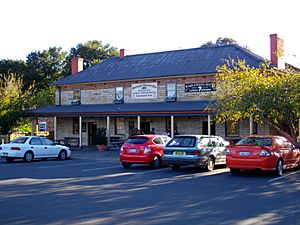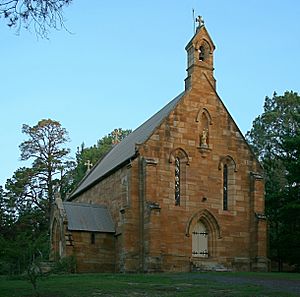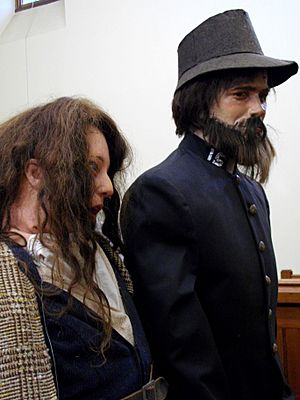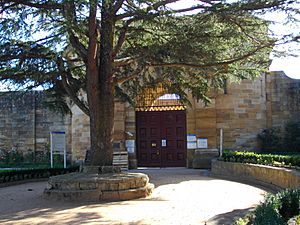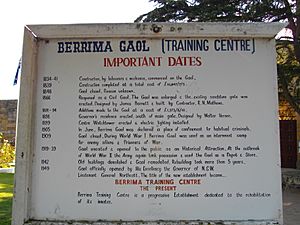Berrima, New South Wales facts for kids
Quick facts for kids BerrimaNew South Wales |
|||||||||||||||
|---|---|---|---|---|---|---|---|---|---|---|---|---|---|---|---|
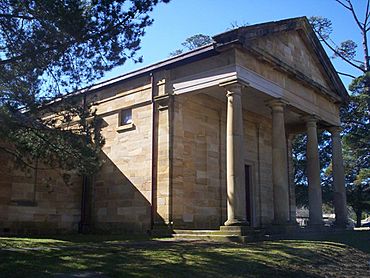
Historic court house in Berrima (completed 1838)
|
|||||||||||||||
| Population | 666 (2016 census) | ||||||||||||||
| Established | 1830 | ||||||||||||||
| Postcode(s) | 2577 | ||||||||||||||
| Location | |||||||||||||||
| LGA(s) | Wingecarribee Shire | ||||||||||||||
| Region | Southern Highlands | ||||||||||||||
| County | Camden | ||||||||||||||
| Parish | Berrima | ||||||||||||||
| State electorate(s) | Goulburn | ||||||||||||||
| Federal Division(s) |
|
||||||||||||||
|
|||||||||||||||
Berrima is a historic village located in the beautiful Southern Highlands of New South Wales, Australia. It's part of the Wingecarribee Shire. This charming village, which used to be a much bigger town, sits right on the Old Hume Highway, a main road connecting Sydney and Canberra. You'll find it near other important towns in the Southern Highlands like Mittagong, Bowral, and Moss Vale.
Contents
What's in a Name?
The name Berrima comes from an Aboriginal word. It might mean "southward" (towards the south) or "black swan".
A Look Back at Berrima's History
The land around Berrima was once home to the Dharawal Aboriginal people. Explorers visited the Wingecarribee River area in the late 1790s. John Wilson, an ex-convict, led one of these trips in 1798.
Later, in 1814, John and Hamilton Hume rediscovered the area. Charles Throsby explored it further in 1818. Soon after, people started to settle there. Harper’s Mansion, a grand house overlooking the town, was built between 1829 and 1830.
The New South Wales surveyor-general, Thomas Mitchell, chose Berrima as the main town for southern New South Wales. This was because another planned town, Bong Bong, often flooded. Berrima was surveyed in 1830, and the town plan was approved in 1831. People hoped Berrima would become a busy centre for trade and making things.
Growth and Change
The famous courthouse was built between 1833 and 1838. The gaol (prison) was built by convict workers starting in 1835 and opened in 1839. The Surveyor General Inn was built in 1834. It has been a hotel ever since, making it one of Australia's oldest continuously licensed pubs.
Berrima became very busy because it was on the Old Hume Highway. In the 1840s, there were fourteen hotels in or near the town! However, when the railway line was built, it bypassed Berrima. This meant fewer people visited, and the town's population dropped. For about 100 years, almost no new houses were built.
In 1896, Sir Henry Parkes, who was the leader of New South Wales, planted an oak tree near the post office. Today, Berrima is known for its many historic buildings. The whole village is listed as a special heritage area. Other important buildings include the Holy Trinity Anglican Church (built in 1849) and the St Francis Xavier Catholic Church (built 1849-51). To help protect these old buildings, the Berrima Village Trust was set up in 1963.
Berrima Court House
The Berrima Court House was built between 1836 and 1838. It was designed by the colonial architect Mortimer Lewis. The building has a grand, classical style with four large columns. It is made from sandstone.
The first major court cases were held here in 1841. The very first trial by jury in the colony of New South Wales took place in this courthouse! However, the main courts only stayed for seven years. In 1850, the district court moved to Goulburn. Smaller local courts continued in Berrima until 1873.
Old Berrima Gaol
Berrima Gaol (prison) took five years to build. Much of the work was done by convicts. Life inside the gaol was very tough. Prisoners spent most of their days in small cells with only a tiny bit of light coming through a grate in the door.
In 1866, the gaol was updated to be a "model prison." But it still had very small solitary confinement cells. These cells were only 8 feet by 5 feet, and prisoners were meant to spend a year in them. In 1877, an investigation looked into complaints about how prisoners were treated, but the complaints were not upheld.
Gaol During Wartime
During World War I, the army used Berrima Gaol as a camp for German prisoners. Most of the 329 people held there were German sailors from shipping companies. There were also German officers from places like Rabaul (now in Papua New Guinea) and even officers from a famous German warship called the SMS Emden.
More recently, the gaol was used as a prison for women with low-to-medium security needs. It closed in 2011 but was scheduled to reopen in September 2016.
Famous People from Berrima
- Keith Steele (1951–2009), a cricketer and lawyer.
- Estelle Asmodelle, a model, music composer, and scientist, who grew up here.
- Louisa Atkinson (1834–1872), a naturalist and writer.
- Geoff Harvey (1935–2019), a well-known musical director for TV.
- Leo Sayer, a famous singer.
- Jimmy Barnes, the lead singer of the band Cold Chisel.



